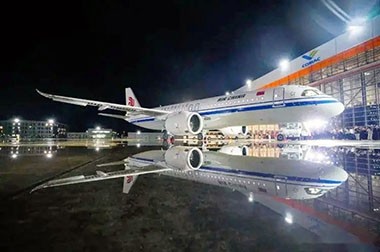What is the difference between 7075 T73 and 7075 T73511?
The difference between 7075-T73 and 7075-T73511 aluminum alloys lies in their heat treatment processes, mechanical properties, and intended applications.
- 7075-T73: Refers to a state achieved through solution heat treatment followed by overaging to obtain specific mechanical properties and stress corrosion resistance. This condition is optimized for stress corrosion cracking resistance, though it sacrifices some strength compared to the T6 state.
- 7075-T73511: A subcategory of the T7351 condition, where the suffix "11" indicates a specific processing method. After solution heat treatment, it undergoes a prescribed amount of stretching to relieve residual stress, followed by artificial aging and final cold finishing for extruded products.
7075-T73 vs 7075-T73511: Heat Treatment and Processing
| Attribute | 7075-T73 | 7075-T73511 |
| Heat Treatment Process | Solution heat treated and then artificially overaged to stabilize the material. | Solution heat treated, stress relieved by stretching, and then artificially overaged. |
| Primary Applications | Thin sheets, plates, forgings. | Extruded products, tubes, applications requiring precise geometric shapes. |
| Stress Corrosion Resistance | Maximized to prevent stress corrosion cracking without the need for further mechanical adjustments. | After stress relief stretching, straightening is permitted to correct dimensional tolerances. |
| Dimensional Accuracy | No special adjustments for dimensional accuracy. | High importance for precise geometric shapes, with allowance for straightening to meet tolerances. |
| Suitable Products | Thin sheets, plates, forgings. | Extruded products, tubes, especially those requiring high dimensional precision. |
| Post-Treatment Adjustments | No mechanical adjustments required after treatment. | Straightening is possible after stretching. |
| Special Processing Requirements | No special post-treatment processes involved. | Stress relief by stretching is a critical step. |
7075 T73 and 7075 T73511 Status Name Breakdown
T73:
"T7" indicates stabilization through overaging. "3" specifies a subcategory optimized for stress corrosion resistance.
T73511:
- T7: Stabilization through overaging.
- 3: Stress relief through stretching.
- 5: Artificial aging.
- 11: Indicates slight straightening after stretching (specific to extrusions).
7075 T73 and 7075 T73511 Standards and Specifications
- 7075-T73: Governed by standards such as AMS 4141 (for forgings) or AMS 4166 (for extrusions).
- 7075-T73511: Defined in AMS 4167 for extrusions, emphasizing compliance with straightening after stretching.
7075-t73 vs 7075-t73511 Summary Table
| Aspect | 7075-T73 | 7075-T73511 |
| Processing | Solution heat treatment + overaging | Adds stress relief + straightening |
| Key Use Case | Sheets, plates, forgings | Extrusions requiring precision |
| Stress Relief | No mechanical stress relief | Stretched + straightened |
| Standards | AMS 4141, AMS 4166 | AMS 4167 |
7075 T73 and 7075 T73511 Mechanical Properties
While both tempers prioritize stress corrosion resistance, slight differences exist:
| Property | 7075-T73 | 7075-T73511 |
| Tensile Strength (MPa) | 500 | 510 |
| Yield Strength (MPa) | 410 | 410 |
| Elongation (%) | 7.1 | 7.5 |
| Fatigue Strength (MPa) | 160 | 160 |
7075-T73 Aluminum
This temper is achieved through solution heat treatment followed by artificial aging. Compared to peak strength tempers like T6, the 7075 alloy offers improved stress corrosion resistance with slightly lower strength, making it ideal for applications where durability and resistance to stress cracking are critical. It is commonly used in rolled or forged parts where additional mechanical stress relief is unnecessary.
7075-T73511 Aluminum
In this temper, after the standard solution heat treatment, the material undergoes stress relief through stretching (as indicated by "51" in the designation), followed by artificial aging. This additional step is typically applied to extruded products to relieve residual stress and improve dimensional stability (reducing warping) without significantly compromising mechanical properties. The process may also include slight straightening after stretching. While the mechanical performance differences are minimal (T73511 typically has slightly improved elongation and fatigue resistance), the key distinction is that the T73511 temper is specifically tailored for extruded shapes that require additional stress relief.
7075-T73 vs 7075-T73511 Stress Corrosion Resistance
- T73: The overaging treatment significantly enhances stress corrosion resistance, making it suitable for applications exposed to corrosive environments over long periods.
- T73511: The stretching process further reduces internal stress, offering better stress corrosion resistance compared to the standard T6 temper, though it may be slightly inferior to T73.
7075-T73 vs 7075-T73511 Machining Suitability
- T73: Suitable for forgings, thick plates, and other directly formed products.
- T73511: Designed for extruded profiles and bars, with cold finishing processes ensuring dimensional accuracy and surface quality.
7075-T73 vs 7075-T73511 Applications
7075-T73:
- Commonly used in aerospace components (such as wing spars and bulkheads) where stress corrosion resistance and moderate strength are critical.
- Applied in sheet, plate, and forging products without the need for complex post-processing.
7075-T73511:
- Ideal for extruded structural components requiring high dimensional accuracy (such as aircraft frames and support beams).
- The straightening step ensures minimal residual stress, making it suitable for high-tolerance applications.




